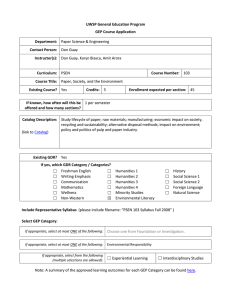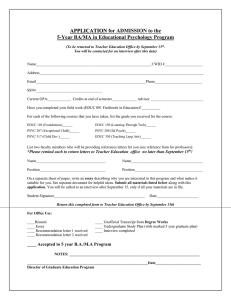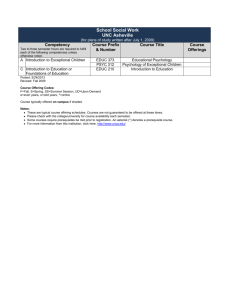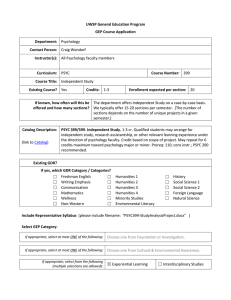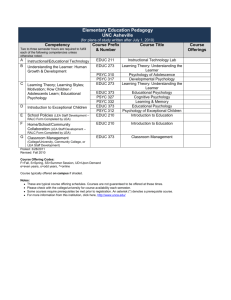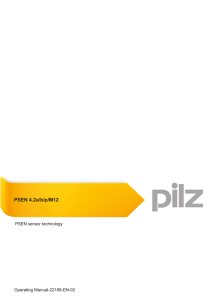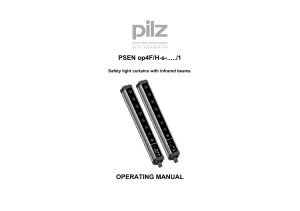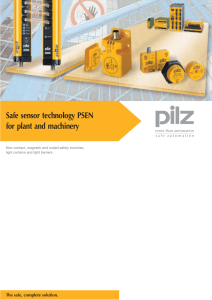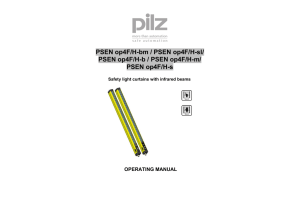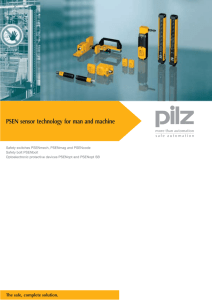Five-Year Assessment Planning Karyn Biasca , Chair of PS &E, ABET Liaison
advertisement
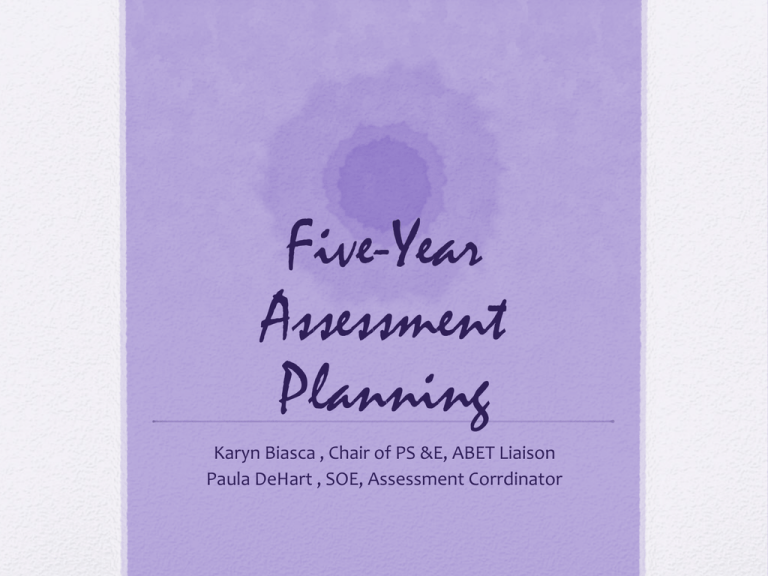
Five-Year Assessment Planning Karyn Biasca , Chair of PS &E, ABET Liaison Paula DeHart , SOE, Assessment Corrdinator This is a little story about four people named Everybody, Somebody, Anybody, and Nobody. There was an important job to be done and Everybody was sure that Somebody would do it. Anybody could have done it, but Nobody did it. Somebody got angry about that because it was Everybody's job. Everybody thought that Anybody could do it, but Nobody realized that Everybody wouldn't do it. It ended up that Everybody blamed Somebody when Nobody did what Anybody could have done Workshop Learning Outcomes • Identify what needs to be included in a five year assessment plan. • Identify all of their assessment requirements including GEP assessment, program/discipline specific accreditation requirements, and other internal or external assessment requirements. • Draft a delineated plan that includes goals/activities for each of the five years and who will carry out these activities • Complete department check-in form Agenda • Review your LOs • Review your curriculum map • Characteristic of an effective plan • Drafting an assessment plan • Documenting your work • Complete check-in form Review your LOs • Do they capture the most important knowledge, skills and dispositions for your graduates? • Are they measureable? • Is there redundancy? • Are there too many? Not enough? LO FAQs • FAQ Handout • Bloom’s Taxonomy Handout Review your curriculum map • Are all LOs addressed? • Are the LOs developed across the curriculum? • Does the map reveal any gaps? • Are assessments embedded in courses? • Is the map organized in a way that is useful? Curriculum Map Examples • Music • School of Education • Paper Science and Engineering Curriculum Map: Music Characteristics of an Effective Plan • Focus on continuous improvement rather than only looking at assessment data when the report is due (annual review). • Five year plan should include both direct and indirect assessments. • Embedding assessments within courses helps to make assessment efforts more reasonable and doable. • You have evidence of what students know and are able to do at the end of the program Characteristics of an Effective Plan • Assessment at other program levels may help to determine what knowledge and skills students have upon entering the program, what students have gained at critical developmental points during their education and to document progress in student learning. Characteristics of an Effective Plan • When developing a five year plan, consider all assessment requirements including GEP assessment, program/discipline specific accreditation requirements and any other internal or external assessment requirements. GEP Assessment Cycle • Foundation Level (FYS, Written and Oral Comm, and Quantitative Literacy) 2013-14, 2017-18 • Investigation Level (Arts, Historical Perspectives, Humanities, Social Sciences, Natural Sciences) 2014-15, 2018-19 • Cultural and Environmental Awareness (Global Awareness, Environmental Responsibility, U.S. Diversity) 2015-16, 2019-20 • Integration Level (Comm and Capstone in the Major, Experiential Learning, Interdisciplinary Learning) 2016-17, 2020-21 Example of Five-Year Plan Psychology: PLOs New PLOs Assessment Method Knowledge base in Psychology Content Exam Scientific Inquiry and Critical Thinking Critical Thinking Test Ethical and Social Responsibility in a Diverse World Indirect Assessments Survey* Communication Embedded PSYC 490 Capstone Classes* Professional Development Indirect Assessments Survey* Year 1 Year 2 Year 3 Year 4 Year 5 X X X X X X X X X X X Example of Five-Year Plan Psychology: GEP GEP Level Social science GEP Communication in the Major Capstone experience in the Major Experiential Learning Assessment Method Embedded in PSYC 110 Embedded in PSYC 200, 400 and 490 Embedded in PSYC 490 Embedded in PSYC 399 Year Year Year Year Year 1 2 3 4 5 X X X X Drafting a plan • Develop a plan that ensures all program learning outcomes are assessed during the five-year cycle that includes both direct and indirect assessments. • Imperative to assess a representative sample of graduating students on all program learning outcomes (capstone and other senior level courses can be extremely important in this process). • Identify other points in the program where assessment data will help the department monitor student progress. Drafting a plan • Build in a process for analysis and reflection on the effectiveness and sustainability of the assessment you have carried out over the five year period. • Delineate assessment goals/activities for each year of the five years, including GEP and accreditation requirements, as well as who is responsible for completing the activities and annual check-in with the Assessment Subcommittee. Annual Assessment Cycle PS&E 1. Review Student Outcomes and Assessment Process 5. Implement curriculum changes 4. Evaluate results, determine what changes in curriculum are needed 2. Assignments Outcomes Portfolios Ethics Assignments Paper Knowledge Exam AAC Presentations 3. Use rubrics to evaluate assignments Documentation • Annual basis • Summarize assessment results and interpret their meaning • Determine actions to be taken based on assessment results • Policy for retention of data and documents Annual Check-in Form • Any questions remaining? FAQs for Writing Learning Outcomes What Specifically is a Learning Outcome? • • • • A statement that describes what a student will know (knowledge), be able to do (skill), and/or value/appreciate (disposition) as a result of a learning experience. Learning outcomes can be written for a major/program (departmental or GEP learning outcomes), a course (learning outcomes included on a syllabus), and/or an individual lesson Phrased in terms of OUTPUTS (student learning) not inputs (what the instructor does in class or assigns). Should be written in the following form including all three components: 1) Students can/will be able to… 2) action verb (see back for a comprehensive list of action verbs from Bloom’s Taxonomy)… 3) specific action/skill they will be able to do (including discipline-specific knowledge, skill, or ability). How Can Learning Outcomes Enhance Teaching and Learning? • • • With each lesson, course, and program, instructors are urged to ask, o What knowledge, skills, and/or dispositions do I want students to get from this? o What evidence can I gather to show that students are getting it? Because learning outcomes must be observable/measurable, evidence can be produced to demonstrate what students are actually learning Assessment evidence provides valuable data for improving instruction and increasing student learning in courses and programs. What Are Some Examples of Well-Written Learning Outcomes? • • • • • Students will be able to read, interpret, and analyze common reference maps Students will be able to apply critical thinking skills to offer a solution to a real-world problem (GEP) Students can create narratives about the past based on primary source documents Students can explain the relationship between genetics and disease risk Students can choreograph a dance reflecting a specific dance style What Are Some Common Mistakes Made When Writing Learning Outcomes? • • • Using vague verbs that are difficult to measure like “learn,” “understand,” or “know.” How will you know if students understand, know, or have learned? Use specific action verbs—you will know students understand if they can explain, describe, summarize, analyze, compare, evaluate, etc. Writing learning outcomes that describe inputs like assignments or lecture content rather than the learning that will occur because of the assignment or lecture. “Students will read essays by significant philosophers of the 19th Century” describes reading assignments students will complete (input), but does not describe what students will know, be able to do, or value, as a result of completing the readings (outcome). Including too many learning outcomes. The best target for the number of learning outcomes for a course or program is 2 – 4 (1 is acceptable if it is very rich, 5 is acceptable if you can make a really strong argument for adding a fifth). Learning outcomes are meant to be broader learning goals targeting important knowledge, skills and dispositions, not a comprehensive listing of discreet skills or bits of knowledge BLOOM'S TAXONOMY (Revised 2001) Learning Outcome Verbs at Each Bloom Taxonomy Level Cognitive Level Knowledge Comprehension Application Analysis Synthesis Evaluation Illustrative Verbs arrange, define, describe, duplicate, identify, label, list, match, memorize, name, order, outline, recognize, relate, recall, repeat, reproduce, select, state classify, convert, defend, discuss, distinguish, estimate, explain, express, extend, generalize, give example(s), identify, indicate, infer, locate, paraphrase, predict, recognize, rewrite, report, restate, review, select, summarize, translate apply, change, choose, compute, demonstrate, discover, dramatize, employ, illustrate, interpret, manipulate, modify, operate, practice, predict, prepare, produce, relate schedule, show, sketch, solve, use write analyze, appraise, breakdown, calculate, categorize, classify, compare, contrast, criticize, derive, diagram, differentiate, discriminate, distinguish, examine, experiment, identify, illustrate, infer, interpret, model, outline, point out, question, relate, select, separate, subdivide, test arrange, assemble, categorize, collect, combine, comply, compose, construct, create, design, develop, devise, explain, formulate, generate, plan, prepare, propose, rearrange, reconstruct, relate, reorganize, revise, rewrite, set up, summarize, synthesize, tell, write appraise, argue, assess, attach, choose, compare, conclude, contrast, defend, describe, discriminate, estimate, evaluate, explain, judge, justify, interpret, relate, predict, rate, select, summarize, support, value Original Source: http://www.nadn.navy.mil/CTL/bloom.htm Definitions remembering previously learned information grasping the meaning of information applying knowledge to actual situations breaking down objects or ideas into simpler parts and seeing how the parts relate and are organized rearranging component ideas into a new whole making judgments based on internal evidence or external criteria Five-Year Assessment Plan Planning Template Assessment Cycle Year and Activities Year One ( ) rd Submit Full Program Assessment Report (3 Thursday in October) Year Two ( ) Year Three ( ) Year Four ( ) Year Five ( ) Reflect on the five-year assessment process Prepare Full Program Assessment Report (Spring) Where Assessed & Who Completes Table 1: Curriculum Map Outcomes Courses CHEM 105 MATH 120 ENGL 101 CHEM 106 MATH 121 COMM 101 PSEN 210 CHEM 325 MATH 222 PHYS 150 PSEN 215 ENGL 202 CHEM 326 CHEM 248 PHYS 250 ECON 110 PSEN 300 PSEN 320 PSEN 350 CHEM 335 MATH 320 PSEN 314 PSEN 326 PSEN 355 PSEN 365 PSEN 385 PSEN 430 PSEN 440 PSEN 460 PSEN 475 PSEN 484 PSEN 410 PSEN 445 PSEN 486 PSEN 489 Gen Ed Req Term 1-F 1-F 1-F 1-S 1-S 1-S 1-S 2-F 2-F 2-F 2-F 2-F 2-S 2-S 2-S 2-S SUM 3-F 3-F 3-F 3-F 3-S 3-S 3-S 3-S 3-F 4-F 4-F 4-F 4-F 4-F 4-S 4-S 4-S 4-S a b F F X F F X F F F F A1 F F F F F F F F c d e f g h F F i F A1 X F F F X X F A1 F A1 F F A1 F A1 A1 A1 A1 A1 A2 A2 F F F F F A1 A1 A1 F A1 A1 A1 A1 A1 F A2 A1 A1 A1 F F F A1 A1 A1 A1 A2 A1 X A1 F A1 A1 A1 A2 l F F A2 F k F F F A1 F F F A1 A1 j A1 A2 A2 A2 A2 A1 F A1 F A2 A2 A1 A2 F A2 F A2 F F A2 A2 F F F A2 F F F A1 A1 A1 A1 A1 A1 A2 A2 A2 A2 A1 A2 F F A2 F F NOTES: Term code: #-F = Year #-Fall semester, #-S = year #-Spring semester, SUM = summer, Var = various semesters Codes in table represent the levels of outcome exposure X = introductory exposure to this outcome, F = develop more familiarity and practice on this outcome, A1 = in-depth instruction and formative assessment of this outcome, A2 = in-depth instruction and summative assessment of this outcome 5 Psychology Department Five-Year Assessment Plan 1. Plan for the next assessment reporting cycle The following table describes our tentative assessment plan for the next assessment cycle for our department program learning outcomes. New PLOs Assessment Method Year 1 Knowledge base in Psychology Content Exam X Scientific Inquiry and Critical Thinking Ethical and Social Responsibility in a Diverse World Communication Professional Development Year 2 Indirect Assessments Survey* Indirect Assessments Survey* *Tentative measure which need to be developed. Year 4 Year 5 X X Critical Thinking Test Embedded PSYC 490 Capstone Classes* Year 3 X X X X X X X X The following table describes our tentative plan to integrate General Education learning outcomes into our assessment plan. Year Year Year Year Assessment Method Year GEP Level 1 2 3 4 5 Social science GEP Communication in the Major Capstone experience in the Major Experiential Learning Embedded in PSYC 110 Embedded in PSYC 200, 400 and 490 Embedded in PSYC 490 Embedded in PSYC 399 X X X X School of Education Curriculum Map for Elementary Education INTASC Standard/ SOE PLO #1 #2 #3 #4 #5 #6 #7 #8 #9 #10 ED 205 ED 200 I I I I I ED 302 D I I I I D D I D I I I I I I I I = Introducing ED 331 D D P D D P P P ED 351 ED 381 ED 382 I I D I I D I I I I D D D I I D I I I I D D D I I I/D I I D = Developing ED 300 ED 309 ED 310 D D D D D D D D D D D D D D D D P D D ED 324 ED 325 ED 383 ED 385 ED 398 ED 400 D P P P P P P P P P P P P P D D D D D D D D D D P D D D D P = Proficiency School of Education Curriculum Map for Special Education INTASC ED Standard/ 205 SOE PLO #1 I #2 I #3 I #4 I #5 I #6 #7 I #8 I #9 I #10 I I = Introducing ED 200 I I ED 302 ED 331 ED 351 D I I I I D D I D I P D D I D D I I P I/D D P I I P I D = Developing ED 381 I I D I I I I D D D Educ 382 ED 300 I I D I I I I D D D D P = Proficiency ED 309 ED 310 ED 385 D D D D D D D D D D D D D D D P D D P D D D ED 356 ED 362 ED 368 ED 378 ED 364 ED 369 ED 397 ED 398 ED 400 D D D D D D D P D D P D D P P D D D D D D D/P D/P D/P D/P D/P D/P D/P D/P D/P D/P P P P P D D D D D D D D D D P P P P P P P P P P P P P P P P P P School of Education Curriculum Map for Early Childhood Education INTASC ED Standard/ 205 SOE LO #1 I #2 I #3 I #4 I #5 I #6 #7 I #8 I #9 I #10 I I = Introducing ED 200 I I ECED 262 ED 302 I D I I D I I I I I I D I D I I I D I I D = Developing ED 331 D D P D D P P P ED 351 I I D ED 381 I I D I I I I I I I/D D I D I D P = Proficiency ED 382 I I D I I I I D D D ED 300 ED 309 ED 310 D D D D D D D D D D D D D D D D P D D ED 324 ED 325 D D D D D D D D D D ECED 366 ECED 368 ECED 398 ED 398 D P P P P D D P D D P P P P P D P P P P D P P P P D P P P P P P P P P P P P P P ED 400 ECED 460 P P P P P P P P P P P P Assessment Plan for the Next Reporting Cycle: School of Education Five-Year Assessment Plan Year One (2014-15) Submit Program Assessment Report, October Local assessment of edTPA Focus group study with students who completed the local edTPA Practicum assessment data (all PLOs) Signature Assessment (Professional Portfolio) data from Methods Courses including Elementary Methods Block*and EDUC 390, (focus on Planning, Content, Instructional Practice, Differentiation, and Assessment, PLOs 4, 5, 6, 7, and 8) Year Two (2015-16) Three-Year Survey of Graduates and Employers (April, 2016) Focus group study with students who complete the first regular edTPA assessment Practicum assessment data (all PLOs) Assessment data from Student Teaching (focus on Professional Responsibility, PLOs 9 and 10) Year Three (2016-17) Practicum assessment data (all PLOs) Signature Assessment (Professional Portfolio) data from Methods Courses and Communication in the Major Courses (Elementary Methods Block*/EDUC 302/EDUC 386, focus on Literacy, Content, and Instructional Practice, PLOs 4, 5, 6, 7, and 8) Assessment data from GEP Integration Level (Experiential Learning, Interdisciplinary, Communication in the Major, and Capstone in the Major Courses must submit course portfolios) Year Four (2017-18) Practicum assessment data (all PLOs) DPI Five-Year Decision for Continuous Review Process Signature Assessment (Professional Portfolio) data from ED 205 (focus on Diversity, the Learner and Learning, PLOs 1, 2, and 3) Year Five (2018-19) Three-Year Survey of Graduates and Employers (April, 2019) Signature Assessment (Professional Portfolio) data from EDUC 331, EDUC 351, EDUC 381, and EDUC 382 (focus on the Learner and Learning and Instructional Practice, PLOs 1, 2, 3, and 7) Reflection on the School of Education assessment process Prepare Program Assessment Report *Elementary Methods Block includes EDUC 309, EDUC 310, EDUC 324, EDUC 325, and EDUC 383 Survey Based on Program Learning Outcomes for the School of Education (Example of Indirect Measure of Program Learning Outcomes) For each of the following School of Education Learning Outcomes/Teacher Standards, please rank the degree to which you feel your Education courses and school practicum experiences/student teaching have prepared you: 1 – Not at all; 2 – Below average; 3 – Average; 4 - Above average; 5 – Very well. School of Education Program Learning Outcome Standard #1: Learner Development The student can explain the central concepts, tools of inquiry, and structures of the disciplines she or he teaches and can create learning experiences that make these aspects of subject matter meaningful for pupils. Standard #2: Learning Differences The student can explain how children with broad ranges of ability learn and develop/provide instruction that supports their intellectual, social, and personal development. Rating 1 2 3 4 5 1 2 3 4 5 Standard #3: Learning Environments The student can explain how pupils differ in their approaches to learning and the barriers that impede learning and can adapt instruction to meet the diverse needs of pupils, including those with disabilities and exceptionalities. 1 2 3 4 5 Standard 4: Content Knowledge The student can implement a variety of instructional strategies, including the use of technology, to encourage children's development of critical thinking, problem solving, and performance skills. 1 2 3 4 5 Standard 5: Application of Content The student can explain and apply principles of individual and group motivation and behavior to create a learning environment that encourages positive social interaction, active engagement in learning, and self-motivation. 1 2 3 4 5 Standard #6: Assessment The student can utilize effective verbal and nonverbal communication techniques as well as instructional media and technology to foster active inquiry, collaboration, and supportive interaction in the classroom. 1 2 3 4 5 Standard #7: Planning for Instruction The student can organize and plan systematic instruction based upon knowledge of subject matter, pupils, the community, and curriculum goals. 1 2 3 4 5 Standard #8: Instructional Strategies The student can explain and apply formal and informal assessment strategies to evaluate and ensure the continuous intellectual, social, and physical development of the pupil. * 1 2 3 4 5 Standard #9: Professional Learning and Ethical Practice The student can apply reflective thought to their teaching practice and evaluate and explain the effects of his or her choices and actions on pupils, parents, professionals in the learning community and others. The student can identify professional growth opportunities and explain how these opportunities might contribute to their teaching success and effectiveness. Standard #10: Leadership and Collaboration The student can build and foster relationships with school colleagues, parents, and agencies in the larger community to support pupil learning and well-being, and demonstrates the ability to act with integrity, fairness and in an ethical manner. Strengths of Program: Areas for Improvement: 1 2 3 4 5 1 2 3 4 5
